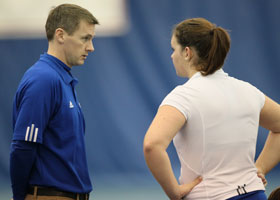Player Advice
Body Language - The Talk of Tennis
by Paul Thomson, Drake Women's Tennis, 20 August 2012
| Share: |  |
|  | |
|
|
The fist-pump, the racquet toss, the stare. The slow trudge off of the court, and the power-energized spring onto the court. The racquet bag bludgeoning after the racquet toss, the chest bump, and the head hang. All of these are familiar sites on the tennis court. But what are these actions - and other body languages on the court - really telling us about the momentum, flow, and even movement within a match or, more minutely, within a single point?

Coach Thomson with his
Drake Team
courtesy, Drake Athletics
Body language can obviously show us that a player is confident and in control - or that a player is down and out. But it can be much more subtle. One of the biggest aspects of tennis that players often forget is the mental and tactical edge that is given up by body language, posture and even body movement. This goes even past the mental/emotional obvious breakdowns such as tossing a racquet, beating a defenseless tennis bag, or simply hanging your head. Both you and your opponents' body language movement and position gives keys on how to respond to a shot, recover, retreat or move forward during a point.
If you've ever seen the movie Sandlot (and if you haven't you should), you know it's "eye on the ball - whereever the ball goes, just move your glove there." Eye on the ball is just as true in tennis as it is in baseball or any another other sport. But eye on your opponent can do as much - and at times even more - for your game. Much of what a player does on the court is not in reaction to the ball but is in response to her opponent. I work on this concept with my players daily in both singles and doubles. It all comes down to recovery, court position, and movement.
The first part of this is in fact ball to your strings, opponent to the ball. Then we apply what I call the "push-pull-stretch" rule. The idea is simple. Forget where you hit the ball. But instead watch your opponent move to the ball. But more importantly watch how and what it takes for them to get to the ball. Are they stepping in behind the ball in position to drive it? Are they charging forward as if to hit an overhead? Are they flatfooted on their heels? Or are they scampering like a rat on a sinking ship (pushed-pulled-stretched) in distress, trying to get to the ball? Now what does that body language, movement or lack thereof tell you that you should do?
Our team trains to look for distress on the other side of the court versus just our well-struck or placed shots. After our shot we work to see how the opponent is reacting or responding. This gives our players an early cue on their next move or response.